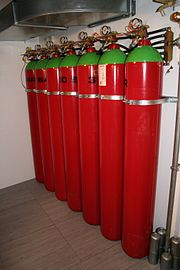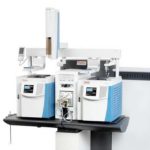- Arian gas company activities in supplying different kinds of industrial, laboratory, and medical gases.
- The company supply these gases, filled in different volume steel cylinder also liquid gas in cryogenic tank system.
- Argon
- Argon is a chemical element with symbol Ar and atomic number 18. It is in group 18 of the periodic table and is a noble gas.[3] Argon is the third most common gas in the Earth's atmosphere, at 0.93% (9,300 ppm), making it approximately 23.8 times as abundant as the next most common atmospheric gas, carbon dioxide (390 ppm), and more than 500 times as abundant as the next most common noble gas, neon (18 ppm). Nearly all of this argon is radiogenic argon-40 derived from the decay of potassium-40 in the Earth's crust. In the universe, argon-36 is by far the most common argon isotope, being the preferred argon isotope produced by stellar nucleosynthesis in supernovas.
- The name "argon" is derived from the Greek word αργον, neuter singular form of αργος meaning "lazy" or "inactive", as a reference to the fact that the element undergoes almost no chemical reactions. The complete octet (eight electrons) in the outer atomic shell makes argon stable and resistant to bonding with other elements. Its triple point temperature of 83.8058 K is a defining fixed point in the International Temperature Scale of 1990.
- Argon is produced industrially by the fractional distillation of liquid air. Argon is mostly used as an inert shielding gas in welding and other high-temperature industrial processes where ordinarily non-reactive substances become reactive; for example, an argon atmosphere is used in graphite electric furnaces to prevent the graphite from burning. Argon gas also has uses in incandescent and fluorescent lighting, and other types of gas discharge tubes. Argon makes a distinctive blue-green gas laser.
- Main applications
Industries Applications Food and Beverage
- Argon can be used in a controlled atmosphere to replace nitrogen in most applications. Its solubility (twice that of nitrogen) and certain molecular characteristics give it special properties for use with vegetables. Under certain conditions, it slows down metabolic reactions and significantly reduces breathing (§ ALIGAL™).
- Glass, Cement and Lime
- Argon is used for the filling of double glazing enclosures for high performance thermal isolation
- Metals industry
- Argon is used to prevent contact, hence interaction, between liquid metal and the surrounding atmosphere. Applications include melt stirring, tun dish purging to prevent steel re-oxidation and secondary steel refining in vacuum degassers, such as the VOD, RH, RH-OB. However, the largest quantities of argon are consumed in the AOD process for decarburising raw high-chromium steels while minimizing the chromium oxidation.
Laboratories & analysis
- Used pure and in mixtures for industrial and hospital analyses and quality control.
- More particularly, argon is used as plasma gas in inductive coupled plasma emission spectrometry (ICP), blanket gas in graphite funace atomic absorption spectrometry (GFAAS) and as carrier gas in gas chromatography for various detector.
- In mixture with methane, argon is used in Geiger counter and in the detector of X Ray Fluorescence (XRF) as quentching gas.
- Welding, Cutting & Coating
- Argon is a shield gas used in arc welding, root shielding and plasma cutting.
- Argon protects welds against oxidation as well as reduces fume emissions during welding.
Electronics
- Ultra-pure argon is used as carrier gas for reactive molecules, as inert gas to protect semiconductors against impurities (e.g. Argon provides the atmosphere for growing crystals of silicon and germanium).
- Under ionic state, argon is used for sputtering, ion implantation, annealing and etching processes in semiconductor or high performance material manufacturing.
- Automotive & transportation
Packaged pressurized argon is used to inflate car airbags. Other industries
- Argon is used as inert atmosphere in incandescent light bulb. Argon filling avoids the corrosion of the tungsten filament and consequently the blackening of the bulb.In mixture with some hydrocarbons, argon is used in radio tubes and Geiger counters.
Miscellaneous uses
- Argon is used for thermal insulation in energy efficient windows. Argon is also used in technical scuba diving to inflate a dry suit, because it is inert and has low thermal conductivity. Argon is being used as a propellant in the development of the Variable Specific Impulse Magnetoplasma Rocket (VASIMR). Compressed argon gas is allowed to expand, to cool the seeker heads of the AIM-9 Sidewinder missile, and other missiles that use cooled thermal seeker heads. The gas is stored at high pressure.
- Argon is used in High Frequency Facial Machines. Developed in the late 1800s by Nikola Tesla, a low level electric current is generated by the machine and passed through clear tempered glass electrodes filled with Argon gas. The electric current ignites the Argon gas and a healing electric light energy is produced. The glass electrode is passed over the skin to produce a multitude of effects. High Frequency treatments have been used to treat acne conditions, soften fine lines and wrinkles, tighten sagging skin, reduce puffiness, improve the appearance of cellulite, and to revitalize the scalp promoting hair growth.
- Argon-39, with a half-life of 269 years, has been used for a number of applications, primarily ice core and ground water dating. Also, potassium-argon dating is used in dating igneous rocks.
- Argon has been used by athletes as a doping agent to simulate hypoxic conditions. On August 31 2014 the World Anti Doping Agency (WADA) added Argon(and Xenon) to the list of prohibited substances and methods, although at this time there is no reliable test for abuse
- Safety
- Although argon is non-toxic, it is 38% denser than air and is therefore considered a dangerous asphyxiant in closed areas. It is also difficult to detect because it is colorless, odorless, and tasteless. A 1994 incident in which a man was asphyxiated after entering an argon filled section of oil pipe under construction in Alaska highlights the dangers of argon tank leakage in confined spaces, and emphasizes the need for proper use, storage and handling.
N6.0 Argon 99.9999% minimum purity Material number Cylinder size Contents Valve 296339-L 50L 10.6m3 BS3 Research Grade Argon 99.9995% minimum purity Material number Cylinder size Contents Valve 293680-L 50L 10.6m3 BS3 293680-V 10L 2.1m3 BS3 298744-BC 2L 0.3m3 BS3 162644-RSH 1L 155L Hose barb 162616-RSQ 1L 155L Quick connector Zero Grade Argon 99.999% minimum purity Material number Cylinder size Contents Valve 270050-L 50L 10.6m3 BS3 270040-V 10L 2.1m3 BS3 111457-AY 20L 2.1m3 BS3 112019-BC 2L 0.3m3 BS3 162636-RSH 1L 155L Hose barb 162615-RSH 1L 155L Quick connector


